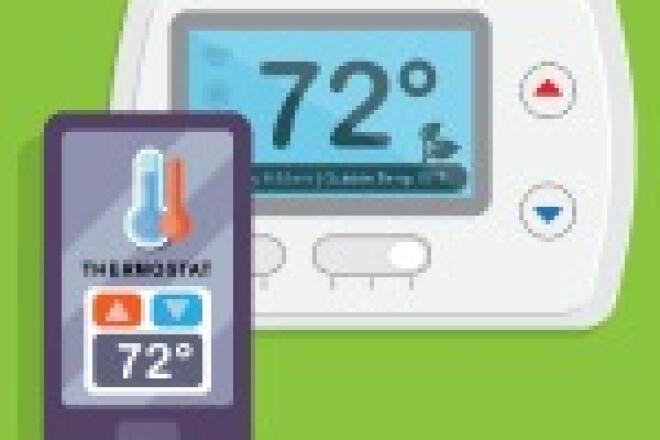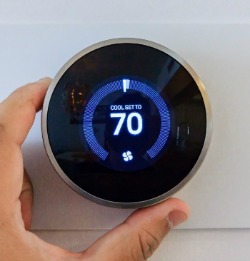
Should You Upgrade to a Smart Thermostat?
In a recent post, we weighed the pros and cons of the LED lightbulb – one of the most proven energy-saving technologies around today. In this blog, we’ll assess the potential benefits of another staple of home energy efficiency – the smart thermostat.
Smart thermostats emerged about a decade ago with the first-generation models from ecobee and Nest (now a part of Google) and have since become one of the most well-known and popular smart home devices. For good reason, these devices promise numerous benefits around convenience, comfort and energy savings.
Smart thermostats can automate a heating and cooling schedule based on either your inputs or habits, and these devices make it possible to adjust your thermostat from your smartphone wherever you are. Some smart thermostats may also use motion sensors or geofencing to automatically detect when you’re home or away or have the ability to be controlled by voice commands.
Today’s smart thermostats seem to be constantly adding new features to help you control your home’s heating and cooling – but are these devices actually living up their promised energy savings? Let’s look at a few factors that you need to consider:
1. Setting a fixed schedule has significant cost-saving benefits on its own.
Before smart thermostats came on the scene, energy efficiency experts recommended installing a programmable thermostat. While not as technologically advanced as today’s smart thermostats, setting these devices on a fixed schedule could save you as much as 10 percent per year on your heating and cooling costs. Smart thermostats can take these energy savings to the next level with their learning capabilities and algorithms.
Smart thermostats can make automatic adjustments to your schedule and heat and cool your home in the most efficient way possible. Others may have the ability to adjust based on the outside temperature, humidity or other environmental factors. It’s projected that smart thermostats can deliver annual savings of 15 percent or more on heating and cooling – but this depends on a variety of factors, including local climate, your current HVAC unit, home size and more.
Regardless, heating and cooling accounts for the majority for energy use in most home’s today, and smart thermostats (or even a programmable thermostat) will help you cut back that energy use if used appropriately.
2. The sticker prices have come down in price considerably in recent years.
 When the second-generation Nest Learning Thermostat debuted back in 2014, the going price for a smart thermostat was $250 or more – no small investment for improving your home’s energy efficiency. However, as the smart thermostat market has matured, there are more and more options out there for every budget. According to the technology website CNET, the Honeywell Lyric T5 is the best budget smart thermostat today (under $120 on Amazon), and Nest offers its own budget Thermostat E that retails around $160.
When the second-generation Nest Learning Thermostat debuted back in 2014, the going price for a smart thermostat was $250 or more – no small investment for improving your home’s energy efficiency. However, as the smart thermostat market has matured, there are more and more options out there for every budget. According to the technology website CNET, the Honeywell Lyric T5 is the best budget smart thermostat today (under $120 on Amazon), and Nest offers its own budget Thermostat E that retails around $160.
However, there is another way to get even cheaper smart thermostats today – your power company. Many power companies are offering rebates or other incentives to help its customers access these devices, since they can help the company manage the electric grid. For example, on the website for Georgia Power, the largest power company in the state of Georgia, customers can currently access an ecobee3 Lite for only $74 after rebate and a top-of-the-line ecobee SmartThermostat for only $144.
If you’re thinking about upgrading to a smart thermostat, you may want to consider checking your power company’s website first. Many offer considerable rebates, which will help you recoup your investment quicker, and some even offer free smart thermostats if you enroll in a new electric rate plan or similar energy-shifting program, which we’ll review next.
3. New electric rate plans have the potential to amplify your savings.
Alongside the considerable improvements in technology, another one of the major changes in the world of energy in recent years has been the emergence of new electric rate plans. Under a traditional electric rate plan, you pay the same price per kilowatt of electricity whether you use it in the morning, afternoon or middle of the night – and regardless of how much it costs your power company to generate it.
However, new rate plans are attempting to better account for fluctuations in how much it costs to generate and deliver energy based on different times of the day. The most common of these is the time-of-use rate, where the day is divided into two or three blocks of varying prices. If you avoid the costliest block (usually around 4 to 8 p.m.) as much as possible, you’ll likely save a bit of money. Some smart thermostats can help you automatically adjust your heating and cooling outside of the more expensive times, saving you even more.
As mentioned in the previous section, some power companies will offer free (or heavily discounted) smart thermostats as a condition of signing up for a time-of-use rate or related program. For example, Detroit-based DTE Energy offers customers a free ecobee smart thermostat for enrolling in the SmartCurrents program, which encourages customers to move their energy use away from hot afternoons in the summer when it becomes very costly for the power company to manage the electric grid.
Should you upgrade to a smart thermostat? Since heating and cooling accounts for the largest portion of a home’s energy use, improving control over this area is a great way to become more energy efficient, and a smart thermostat is an excellent way to gain control. However, there are several factors to consider here, including the cost to acquire the smart thermostat, the square-footage of your home, the amount of your typical power bill and more. A good first step is reaching out to your power company (or visiting their website) to see if there are any rebates or programs that apply to you or to check if they can help you estimate your potential savings.
If you want to learn more about smart home technology and its energy-saving potential, check out our infographic and FAQ here.



